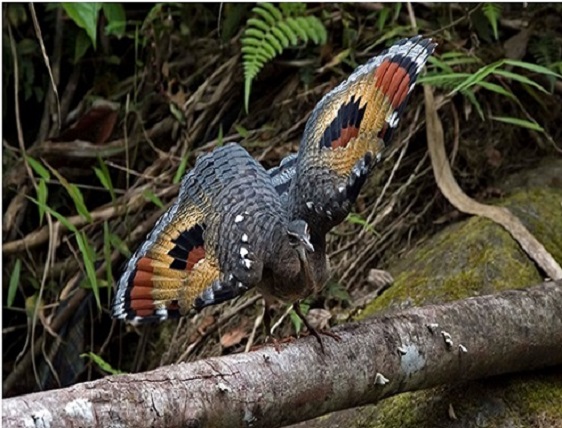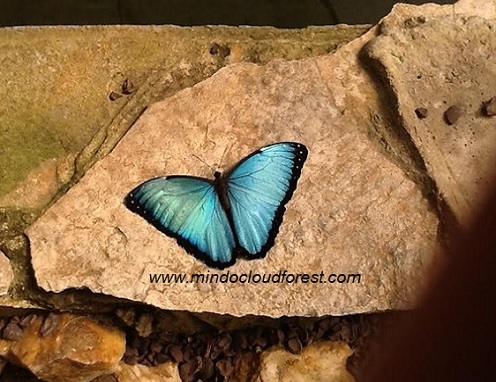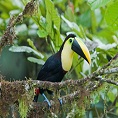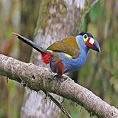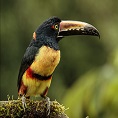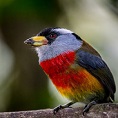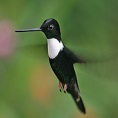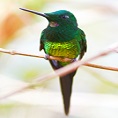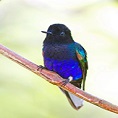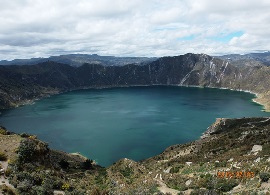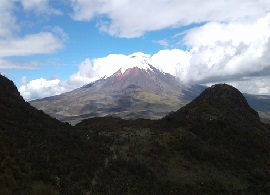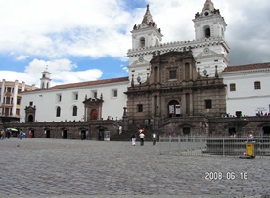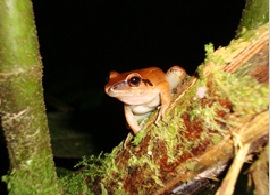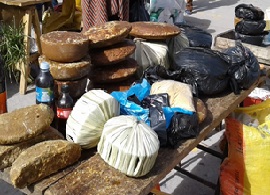Do birding but not in bird feeders.
A professional bird guide does not take you to bird feeders and not even to pseudo Cloud forest Reserves. Please make sure that your money really supports Nature !
Check here with the Ecuadorian authorities if that Reserve is legally existing:
National System of Protected Areas
Check here if that Private Reserve belongs to Socio Bosque:
Forest Protection Program
To preserve the ecosystem is necessary to hire a professional who understands how the ecosystem works and be able to pass onto our worth visitors the message. Simply do a Symbiosis where tourists and locals seriously compromised with the ecology we do work together.
The preservation of the primary and pristine forest which requires an ecological compromise.
These kind of tours are for people who really appreciate nature in its fullest and with an ecological concern.
When you book a nature tour of the cloud forest, make sure your tour operator and tour guide are both licensed and have an ecological concern.
Here some tips while taking photos
Please avoid the use of flush even those cameras with latest technology are causing an impact on birds.
If you meet others in places where there are signs like NO FLASH and you see tour guides allowing the use of flush, PLEASE kindly advise them to consider NOT TO USE IT.
For night excursions please avoid using too much flush lights (share it).
PLEASE THINK GREEN and help us to behave GREEN as well.
LITTLE THINGS MIGHT MAKE BIG DIFFERENCES
Please avoid to buy Insect Spray repellent buy an atomizer. The use of CFC (Chlorofluorocarbon) contributes to ozone depletion in the upper atmosphere.
When buying plastic bottle water of 500ml we contribute of use of too much plastic. Please try to buy bottles of 1 or 2 liters or bring your own water bottle to refill it, camelback, etc.
For night excursions please avoid using too many flush lights (share it) that requires batteries and it might contain mercury.
Avoid as much as possible the use of flush while taking bird photos.
Please think about hummingbird´s job.
Avoid to visit hummingbird feeders with TOO many feeders of sugared water. These great birds forget their job of pollinating wild flowers.
The concentration of too many visitors in one single place (in nature) might cause an ecological impact.
There are other places where they do also need your support. Visit them !
Our tours are exclusively environmental education. People in search of other interests that are not ecotourism, we strictly reject it.
ECO CONCERN
Sugared feeders might be killing hummingbirds? Brightly-colored flowers that are tubular hold the most nectar
Banana with not natural ripening is toxic for birds/toucans do birding in natural spots
How This Online Community Changed Birding Forever Undeniably, eBird has changed birding culture?
When internet lets us love nature a litle too much People like to make lists
The Guardian a movement is gaining momentum that grants legal rights to natural phenomena.
The Galapagos islands-consevation-crisis Leave No Trace, the massive concentration of tourists in one single place creates an ecological impact, have a look what is happening with "the Galapagos islands".
The Galapagos islands-consevation-crisis A barge carrying 2,000 litres of diesel has sunk at a dock on San Cristóbal Island in the Galápagos archipelago. .
ACCELERATED RIPENING OF FRUITS
By Kepti Lenin Tinoco Moreno, Chemical engineer from Guayaquil
For several decades, in Ecuador calcium carbide ( formula: CaC2 ) has been used for accelerated ripening of fruits, especially bananas. From my own experience and from information from people who know about the subject, I know that this bad practice has also extended to other fruits.
The serious thing is that according to all the evidence, the use of calcium carbide is completely widespread to the point that ripened fruits are sold with this toxic substance.
A business known in the country today is banana ripening to provide street vendors, stores, pantries, markets, supermarkets, and so on. When calcium carbide is mixed with water, mainly acetylene and calcium hydroxide are produced, traces of arsenic and phosphorus can also be generated.
COMMERCIAL MELLOWING
Maturation can be induced and accelerated with an ethylene treatment in the ripening chambers. In many cases the fruits are harvested in places distant from the point of consumption, so they are transported green and then ripened at the destination and can be disposed of outside their normal time.
Commercially prepared mixtures with ethylene are used to accelerate the ripening processes of the fruit sold in the market, which improves the quality of consumption of the fruits.
The substance that produces the effect of accelerated ripening in fruits is acetylene in the gaseous state. For example, anyone can differentiate the taste of a naturally ripened banana from a ripened banana with calcium carbide.
The taste of naturally ripened fruit is much more palatable. The matured with calcium carbide has a strange taste (something like a chemical that burns the stomach) for a person who is accustomed to the natural.
What are the health damages caused by acetylene and traces of arsenic and phosphorus? It will depend on the amount ingested, but in any case the FDA (agency of the US government for the control of toxic substances and food) is prohibited from using calcium carbide for its use in Ecuador.
In summary, the damages to health, according to specialists who have studied the subject, are: allergic manifestations, memory loss, eye irritation, itchy mouth, numbness, numbness of arms and legs, burning sensation when eating the fruit. It is also known that acetylene has carcinogenic properties, apart from being a highly flammable and explosive gas. People who handle calcium carbide are exposed, of course, to all the symptoms indicated above.
Accelerated fruit ripening is possible technically, but not with the use of calcium carbide. This substance is used in some third world countries because of its economic and easy access, without measuring the serious consequences for the health of people.
Could any authority in Ecuador take action on the matter to investigate this very important issue?
PESTICIDE MANAGEMENT IN THE BANANA INDUSTRY
By Food and Agriculture Organization of the United Nations
The use of pesticides to control pests and diseases is extensive in banana plantations, particularly in those that produce for export and throughout the year. Banana crops are particularly susceptible to infestations as most are grown in the tropics, favouring conditions for pests. Pesticides are used to control different banana pests, including Black Sigatoka, a leaf-spot disease of banana plants caused by the ascomycete fungus Mycosphaerella fijiensis, which in banana plantations can significantly decrease yields by 35% to 50%.
MATURATION PROCESS
By Horticultivos: investigation
In the ripening process, the fruit breathes taking O2 from the air and giving off CO2. The factors that influence the fruit ripening process are:
Temperature: Increasing the temperature increases breathing and accelerates the ripening process of the fruit and in turn lowering the temperature generates an inverse effect.
Oxygen: The fruit consumes oxygen during ripening, the higher the percentage of O2 present the faster the process.
Carbon dioxide: Increasing the concentration of CO2 slows the ripening process.
Ethylene: During the ripening of the fruit, small amounts of ethylene are released, whose presence stimulates the process. Pure ethylene cannot be used as it is a flammable gas on contact with oxygen, so it is combined with N2 until a non-flammable mixture is achieved.
Humidity: As a result of the respiratory process, the fruit loses moisture and its appearance deteriorates. Therefore, it is recommended to maintain a humidity of 88-98 percent.
THE NATURAL RIPENING OF THE FRUITS
By Horticultivos: investigation
Naturally, a large number of fruits ripen due to the action of ethylene, a hormone produced by the fruits and that, as the concentration increases, the ripening process is accelerated, modifying the color, firmness, flavor and characteristic aromas of each fruit.
Ethylene is a very volatile substance generated by fruits during maturity, so it is considered a ripening hormone. Due to the ripening effect, the starch of the fruits is transformed into sugars (fructose and glucose), the tannins (characteristic compounds of the “green” fruit that give it a bitter taste) are also reduced, and the pH increases, reducing the acidity.
All these transformations contribute to make the fruits more pleasant to our palate by mixing the acidic flavors with the sweets. On the other hand, the colors of the fruits are accentuated more when they are ripe, this means that the concentrations of carotenes (yellow, orange, red) and anthocyanins (red, purple, blue) increase.
CLASSIFICATION OF FRUITS BY THEIR FORM OF MELLOWING
Not all fruits are harvested when they are in commercial maturity. Some fruits require several days to complete the maturity once harvested, others on the contrary, they must be harvested at their optimum point of maturity, because if they are harvested “green” they will not ripen once cut from the tree or plant. In some cases, the fruits have reached sufficient maturity to be commercialized, however, they still have some green areas, reducing their acceptability on the part of the client.
From the point of view of how the fruits ripen, we can classify them into: climacteric and non-climacteric fruits.
For climacteric fruits, like: apple, pear, peach, fig, plum, melon, watermelon, blueberry, tomato, custard apple, avocado, banana, mango, papaya and kiwi. The maturity process is initiated according to changes in its hormonal composition. It is not a gradual process, a maximum peak of maturity occurs and then begins to decline until aging begins. The beginning of climacteric maturation is a well defined process that is characterized by a rapid increase in the speed of respiration and the evolution of ethylene by the fruit. The climacteric fruits have the ability to continue ripening even separated from the plant, provided they have reached a physiological state that ensures ethylene production, therefore, this type of fruit is usually harvested when they are still somewhat "green", continuing the maturation process separated from the plant.
On the contrary, in relation to non-climacteric fruits, like: cherry, grape, raspberry, orange, lemon, lime, tangerine, strawberry, cucumber, bell pepper and pineapple. The maturity process is a gradual and continuous process. Non-climacteric fruits lack the ability to continue ripening once separated from the plant, so it must be ensured that they have reached an appropriate state of maturity for consumption at the time of harvest.
Citrus fruits are typical examples of non-climacteric fruits and in them ethylene does not regulate ripening, that is, they do not ripen by ethylene. However, ethylene is able to accelerate the degradation of chlorophylls, pigments responsible for the green color of the fruits. For the marketing of citrus fruits a certain degree of coloration is required, for that reason ethylene is applied in order to accelerate the elimination of the green color of those fruits, that is, for aesthetic reasons.
These fruits (not climacteric), even if they are allowed to ripen a few days, if they have not been harvested at their optimum time, they will follow a natural aging process. They will not vary neither their flavor nor their color.
